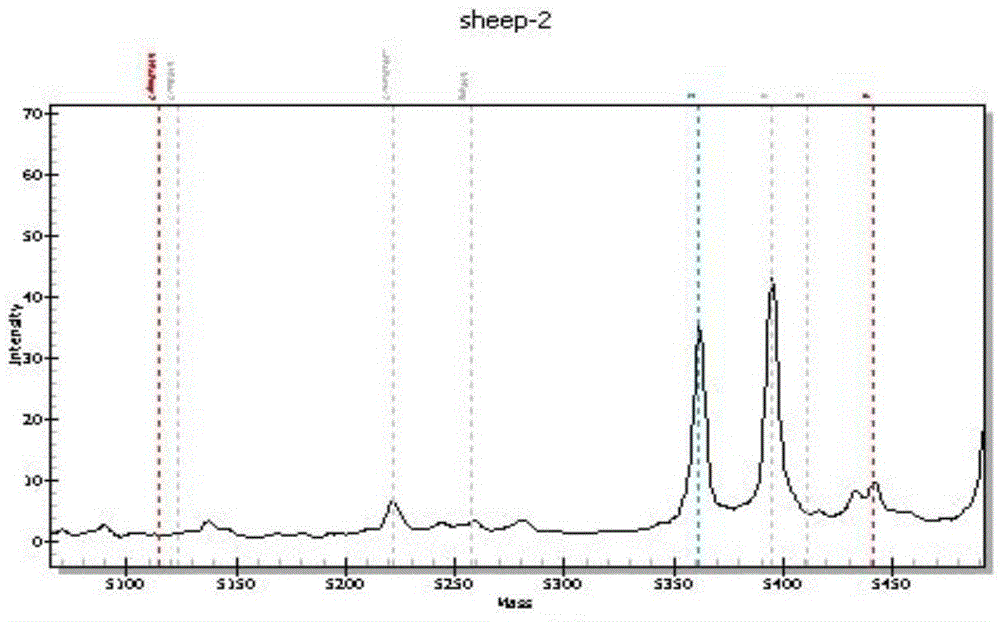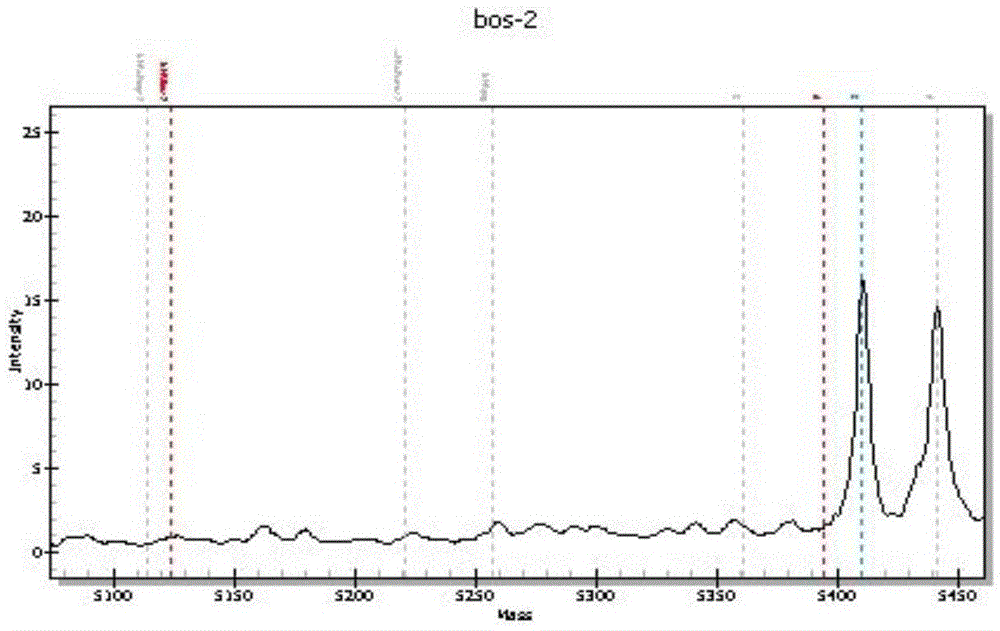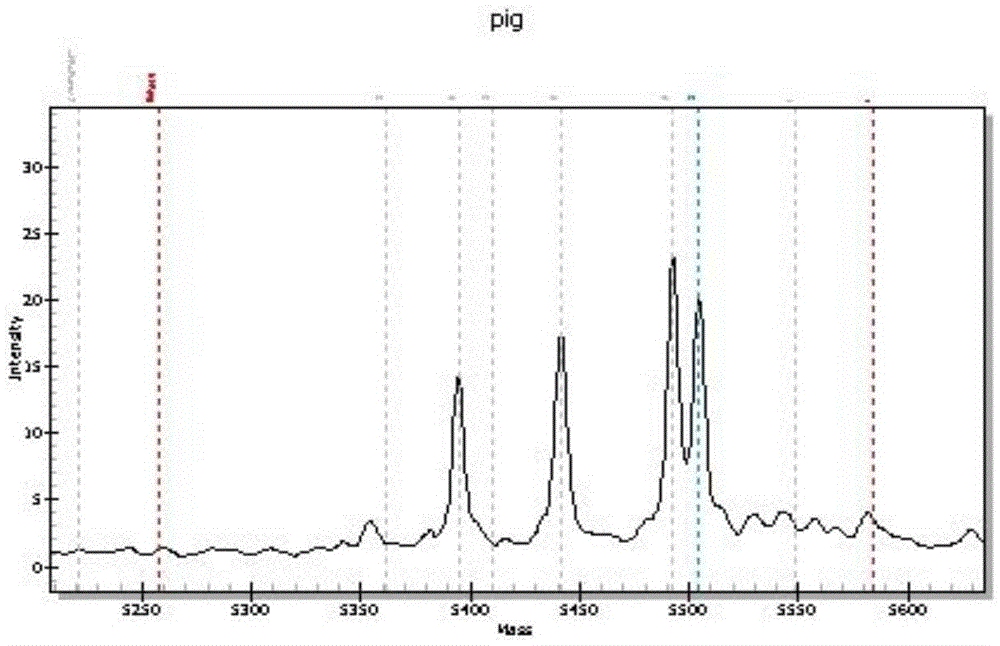Identification of animal-derived components in meat products by mass spectrometry
An animal-derived component and animal-derived technology, applied in the field of kits, can solve problems such as sensory properties, protein component destruction, meat product trading and import inconvenience, and difficult to accurately identify trace components, achieving low false positives and high detection results. Accurate and stable results with a high degree of automation
- Summary
- Abstract
- Description
- Claims
- Application Information
AI Technical Summary
Problems solved by technology
Method used
Image
Examples
Embodiment 1
[0063] Example 1: Primer design and synthesis.
[0064] The core sequences of universal PCR primers (SEQ ID No: 1 to SEQ ID No: 2) and specific extension primers (SEQ ID No: 3 to SEQ ID No: 8) were designed for pigs, cattle, sheep, chickens, ducks, and rabbits.
[0065] Among them, in order to prevent the PCR primers from entering the detection window of the mass spectrometer and interfering with the detection effect, the 5' end of each PCR primer can add a certain number of bases on the basis of the core sequence (SEQ ID No: 1 to SEQ ID No: 2), such as 10 bp tag (ACGTTGGATG) to increase the molecular weight of the PCR primers so that they exceed the detection window of the mass spectrometer.
[0066] Relevant primers were synthesized at Sangon Bioengineering (Shanghai) Co., Ltd.
[0067] The following detection process is performed according to the "Meat Product Identification Kit (Time-of-Flight Mass Spectrometry) Instructions" (hereinafter referred to as "Instructions") is...
Embodiment 2
[0068] Example 2: Extraction of genomic DNA in standard meat products.
[0069] Buy one piece of pig, cow, sheep, chicken, duck, and rabbit adult tissue (such as front leg or hind leg) in the market, and select an appropriate amount of muscle tissue inside the tissue. Use a commercial nucleic acid extraction kit (such as QIAGEN's DNeasyBloodandTissuekit) to extract genomic DNA from muscle tissue. To extract DNA from mixed meat, the steps are as follows:
[0070] A. Take 4g of mixed meat, grind it into meat powder at room temperature, put the meat powder in a 10ml centrifuge tube, add 1ml of STE liquid, 1ml of 10% SDS liquid by volume, 150μl of 20mg / ml proteinase K, Water bath at 56°C for 1-3h;
[0071] B. Add it into 5ml of phenol-chloroform-isoamyl alcohol mixture, mix well, and centrifuge for 4min with a 10000rpm centrifuge; wherein the volume ratio of phenol-chloroform-isoamyl alcohol mixture is phenol 25: chloroform 24: isoamyl alcohol amyl alcohol 1;
[0072] C. Absor...
Embodiment 3
[0077] Embodiment three: standard biological experiment.
[0078] Using ABI9700 PCR instrument, the extracted genomic DNA was tested according to the instructions.
[0079] The components used in the kit for PCR, PCR product purification and single base extension are:
[0080] serial number
component name
main ingredient
Specification
1
PCR mix
dNTPs, MgCl2, PCR primers
360ul / tube x1 tube
2
PCR enzyme
Taq enzyme
24ul / tube x1 tube
3
SAP Enzyme Mix
SAP enzyme
24ul / tube x1 tube
4
Extension Primer Mix
extension primer
24ul / tube x1 tube
5
elongase mix
iPLEX enzymes, ddNTPs
24ul / tube x1 tube
[0081] According to the manual, the specific operation method is as follows:
[0082] 1. PCR amplification
[0083] 1.1 In the PCR preparation area, prepare 200ul PCR reaction tubes according to the number of samples to be tested (including positive quality control produc...
PUM
 Login to View More
Login to View More Abstract
Description
Claims
Application Information
 Login to View More
Login to View More - R&D
- Intellectual Property
- Life Sciences
- Materials
- Tech Scout
- Unparalleled Data Quality
- Higher Quality Content
- 60% Fewer Hallucinations
Browse by: Latest US Patents, China's latest patents, Technical Efficacy Thesaurus, Application Domain, Technology Topic, Popular Technical Reports.
© 2025 PatSnap. All rights reserved.Legal|Privacy policy|Modern Slavery Act Transparency Statement|Sitemap|About US| Contact US: help@patsnap.com



